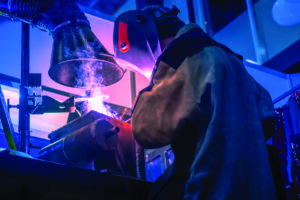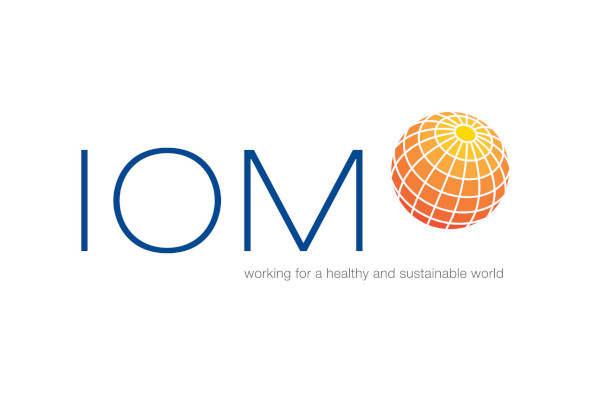We need a more precautionary approach to managing welding fume exposure, says Professor John Cherrie of the Institute of Occupational Medicine (IOM).
 WELDING FUME is more dangerous than we have previously realised, and it doesn’t matter what type of metal is being welded or the process being used. It is now unacceptable to weld indoors without the provision of effective engineering controls, such as local exhaust ventilation, and in many situations, it may also be necessary to wear respiratory protective equipment to protect workers from residual fume. In this article we explain the scientific basis for these recommendations and set out practical advice for employers and welders.
WELDING FUME is more dangerous than we have previously realised, and it doesn’t matter what type of metal is being welded or the process being used. It is now unacceptable to weld indoors without the provision of effective engineering controls, such as local exhaust ventilation, and in many situations, it may also be necessary to wear respiratory protective equipment to protect workers from residual fume. In this article we explain the scientific basis for these recommendations and set out practical advice for employers and welders.
Welding is undertaken in many industries. In the UK there are about 200,000 welders, with a bit less than half working as professional welders and the rest undertaking some welding in their job. It’s a hazardous work, and welders are exposed to metal fume and hazardous gases in the air, ultraviolet (UV) radiation from the arc, noise and other hazards. Exposure to welding fume depends on the composition of the metal being joined, the welding process, and where the work is undertaken, but levels can be above 10 mg/m3 in the absence of effective controls. There has been concern in the scientific community that long-term exposure to welding fumes could cause lung cancer, particularly from welding stainless steel because it contains hexavalent chromium, which is a known carcinogenic metal. For this reason, the Health and Safety Executive (HSE) previously recommended strict levels of control when welding stainless steel.
Two years ago, the International Agency for Research on Cancer (IARC), a part of the World Health Organisation, carefully reviewed the scientific and medical evidence on the health effects of welding and concluded that welding fumes are carcinogenic to humans. They identified an increased risk of lung cancer and possibly kidney cancer. Their conclusions on carcinogenicity were based on the human epidemiological evidence and the available animal toxicity data, although the human evidence was particularly persuasive. There are four large carefully conducted epidemiological studies that were most informative about the risks for lung cancer. These studies show there is no evidence that the metal content or the type of welding process makes a difference to the lung cancer risk. In fact, one of the epidemiological studies showed similar risks for iron oxide fume, regardless of the process generating the fume. The lung cancer risks were apparent for welders who had cumulative exposure over a 45-year working life equivalent to average levels between 0.2 and 1.1 mg/m3.
The Workplace Health Expert Committee (WHEC) reviewed the evidence for the HSE and this has resulted in a further tightening of the controls required for all welding fume under the Control of Substances Hazardous to Health (COSHH) Regulations. In particular, it is expected that for:
Indoor welding tasks, effective engineering controls, e.g. local exhaust ventilation, will be used, and workers may also be required to wear respiratory protective equipment (RPE) for any residual fume exposure; and for
Outdoor welding tasks, respiratory protective equipment (RPE) will be worn.
Suitable exposure controls must always be in place; HSE considers that given the seriousness of the potential health effects associated with exposure to welding fume, it doesn’t matter whether the work lasts for only a short time. No distinction should be made for the control measures required while welding stainless steel or welding other metals, although there is still a requirement to comply with the specific Workplace Exposure Limits for the metals in the fume, e.g. manganese (0.2 mg/m3 for inhalable aerosol and 0.05 mg/m3for respirable aerosol, both over 8-hours), nickel (0.1 mg/m3 as inhalable aerosol over 8-hours) or hexavalent chromium (0.05 mg/m3 as inhalable aerosol over 8-hours).
The IOM agrees that no distinctions should be made between different base metals being welded when selecting appropriate control measures and we endorse the advice from HSE. We further advise our clients that whenever it’s practicable they should use portable local ventilation for outdoor welding. IOM occupational hygienists now advise our customers to ensure that metal fume exposure amongst their workers are as low as is technically possible, and certainly less than 1 mg/m3 while welding is taking place, i.e. not averaged over the workday as is often the case for exposure assessments. When is it likely that exposure will be above 1mg/m3 we recommend the welder and any other workers exposed to such conditions should wear suitable RPE.
The question is how to decide when the use of respirators is appropriate? It’s well known that fume exposure levels during welding vary depending on the welding process, the size of the workroom, the amount of general ventilation and the way the welder works. Welding fume rises rapidly from the arc to form a plume, which is generally visible. If the welders head is in this plume then their exposure will be very high; local ventilation control can help minimise this, but welders should be instructed to avoid the weld plume. If the welder sometimes has their head in the plume because of the circumstances of the work, then they must wear suitable RPE. We recommend that work in small (<300 m3) or poorly ventilated spaces (<0.3 air change per hour) should always be carried out with respiratory protection. Remember welding in confined spaces requires special considerations to ensure it is safe because of the possibility of oxygen depletion. Ventilation systems Most common arc welding process, such as gas metal arc welding (sometime known as MIG or MAG welding) and shielded metal arc welding (SMAW, also known as manual metal arc welding) can give rise to welding fume concentrations between 3 and 30 mg/m3 in an open workshop without local ventilation controls. We know that the effectiveness of ventilation systems is highly variable and depends on both the design and the way that the system is used by the welder. In general, you might expect a reduction in exposure of about 60 to 90% with local ventilation, although mobile fume extraction systems will be more variable in performance and less effective, maybe between 20 – 80% effective. Therefore, unless you are confident that you have an effective ventilation system, we would also advise wearing a respirator in larger workshops (>300 m3).
Gas Tungsten Arc Welding (GTAW sometimes described as TIG welding) will generally have low inhalable aerosol exposures, and low hexavalent chromium and nickel concentrations when welding stainless steel. For this type of welding we would suggest that it is sufficient to just rely on local exhaust ventilation. However, GTAW welding can generate high levels of ozone gas and so it is important to ensure the ventilation is effective. On tool extraction, where the welding hand piece has its own air extraction system to remove contaminants closer to the point of their production, have been shown to be very effective. Such systems may be better suited or used in addition to stand alone local exhaust ventilation units.
On tool extraction has been dismissed by welders in the past, saying it can interfere with welding gas supply, but systems have improved greatly and that is really a myth these days. Other welding or related processes, e.g. gas welding or oxygen arc gouging, will differ in the extent of their exposure and the circumstances where the welding is undertaken will also influence the exposure. In all cases employers have an obligation to complete a suitable and sufficient assessment of the risks to health under the Control of Substances Hazardous to Health Regulations.
There are a number of sources of information that can assist in assessing the level of risk from welding fume exposure and in selecting appropriate local ventilation and respiratory protection. For example, the British Occupational Hygiene Society (BOHS), as part of their Breathe Freely campaign, have an online welding fume assessment tool to help identify appropriate control measures. The Healthy Working Lives initiative in Scotland has produced an online respirator selection tool that guides the user through what can be a rather complex selection process. Both of these tools are freely available and easy to use.
Remember, workers need to be properly trained to understand the risks from welding fume and what steps are needed to ensure they are protected. All engineering controls used in welding need to be suitably maintained and tested at the relevant intervals, and make sure that respirators are managed within a comprehensive RPE programme, including face fit testing. In the end, it may be worthwhile getting some professional advice from an experienced occupational hygienist to ensure you have the best solution for your workplace, IOM can provide Workplace Protection against substances hazardous to health. Managing occupational exposure to welding fumes visit www.iom-world.org/occupational-hygiene/welding-fume-exposure/
Details of IOMs occupational hygiene services can be found at www.iom-world.org/occupational-hygiene/
For more information contact: Call IOM Workplace Protection on 08458 737 202
Complete a quick online quote via www.iom-world.org/occupational-hygiene/quick-quote/
Resources
HSEs Safety Alert is available on their website: www.hse.gov.uk/safetybulletins/mild-steel-welding-fume.htm
There is guidance and further information on the HSE welding subsite: www.hse.gov.uk/welding/guidance/index.htm
The British Occupational Hygiene Society (BOHS) provides an online welding fume assessment tool to help identify appropriate control measures: www.breathefreely.org.uk/wst/
HealthyWorkingLives.scot has an RPE selector tool on their website: www.healthyworkinglives.scot/resources/rpe-selector-tool/Pages/default.aspx

